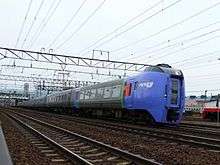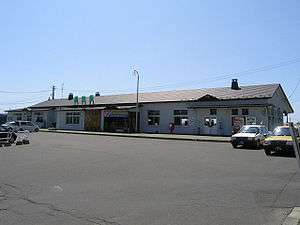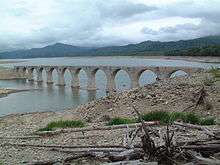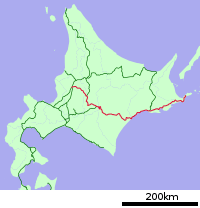Nemuro Main Line
| Nemuro Line | |||
|---|---|---|---|
|
A KiHa 283 series DMU between Shakubetsu and Ombetsu | |||
| Overview | |||
| Type | Regional rail | ||
| Locale | Hokkaido | ||
| Termini |
Takikawa Nemuro | ||
| Stations | 68 | ||
| Operation | |||
| Opened | 1901 | ||
| Owner | JR Hokkaido | ||
| Technical | |||
| Line length | 443.8 km (275.8 mi) | ||
| Track gauge | 1,067 mm (3 ft 6 in) | ||
| Electrification | None | ||
| |||
Nemuro Main Line (根室本線 Nemuro Honsen) is a railway line in Hokkaido operated by Hokkaido Railway Company (JR Hokkaido), connecting Takikawa Station in Takikawa and Nemuro Station in Nemuro, including Obihiro and Kushiro. Higashi-Nemuro is the most easterly situated station on the Japanese rail system.
On 19 November 2016, JR Hokkaido's President announced plans to rationalise the network by up to 1,237 km, or ~50% of the current network,[1] including closure of the Nemuro Line between Furano and Kami-Ochiai Junction. The section between Kushiro and Nemuro is proposed for conversion to Third Sector operation, but if local governments are not agreeable, such sections will also face closure.
Services

The line is roughly divided into three segments. The segment between Takikawa and Shintoku is now a quiet local line. The rapid train Karikachi (狩勝) runs twice a day, and there is one local train service every 1 to 2 hours.
The segment between Shintoku and Kushiro remains a part of the important trunk route between Sapporo and eastern Hokkaido. The limited express train Super Ozora runs between Sapporo and Kushiro six times a day, while the Super Tokachi runs twice a day, Tokachi four times a day, both between Sapporo and Obihiro. There is one local train service every 1 to 2 hours.
The segment between Kushiro and Nemuro is again a quiet local line. This segment has the official nickname Hanasaki Line (花咲線 Hanasaki-sen). There are two rapid trains Nosappu (ノサップ) and Hanasaki (はなさき) which run once a day each. Other than that, there is one local train service every 2 to 3 hours.
Stations
- LE: Limited express
- R: Rapid
- All trains stop at stations signed "+". Some trains stop at "*". No trains (other than local) stop at "-".
| No. | Station name | Japanese | Distance (km) | LE | R | Transfers | Location (all in Hokkaido) |
|---|---|---|---|---|---|---|---|
| A21 | Takikawa | 滝川 | 0.0 | + | ■ Hakodate Main Line | Takikawa | |
| T22 | Higashi-Takikawa | 東滝川 | 7.2 | - | |||
| T23 | Akabira | 赤平 | 13.7 | + | Akabira | ||
| T24 | Moshiri | 茂尻 | 17.2 | * | |||
| T25 | Hiragishi | 平岸 | 20.7 | - | |||
| T26 | Ashibetsu | 芦別 | 26.6 | + | Ashibetsu | ||
| T27 | Kami-Ashibetsu | 上芦別 | 30.5 | * | |||
| T28 | Nokanan | 野花南 | 35.2 | * | |||
| T29 | Shimanoshita | 島ノ下 | 49.1 | - | Furano | ||
| T30 | Furano | 富良野 | 54.6 | + | JR: ■ Furano Line | ||
| T31 | Nunobe | 布部 | 60.9 | * | |||
| T32 | Yamabe | 山部 | 66.7 | + | |||
| T33 | Shimo-Kanayama | 下金山 | 74.7 | * | Minamifurano, Sorachi | ||
| T34 | Kanayama | 金山 | 81.6 | * | |||
| T35 | Higashi-Shikagoe | 東鹿越 | 94.8 | * | |||
| T36 | Ikutora | 幾寅 | 98.8 | + | |||
| T37 | Ochiai | 落合 | 108.2 | * | |||
| Kami-Ochiai Junction | 上落合(信) | 112.2 | - | ||||
| K23 | Shintoku | 新得 | 136.3 | + | + | ■ Sekishō Line | Shintoku, Kamikawa |
| K24 | Tokachi-Shimizu | 十勝清水 | 145.4 | * | + | Shimizu, Kamikawa | |
| K25 | Haobi | 羽帯 | 152.9 | - | - | ||
| K26 | Mikage | 御影 | 155.9 | - | * | ||
| K27 | Memuro | 芽室 | 166.5 | * | + | Memuro, Kasai | |
| K28 | Taisei | 大成 | 168.6 | - | - | ||
| K29 | Nishi-Obihiro | 西帯広 | 173.4 | - | * | Obihiro | |
| K30 | Hakurindai | 柏林台 | 176.6 | - | - | ||
| K31 | Obihiro | 帯広 | 180.1 | + | + | ||
| K32 | Satsunai | 札内 | 184.9 | - | Makubetsu, Nakagawa | ||
| K33 | Inashibetsu | 稲士別 | 188.5 | - | |||
| K34 | Makubetsu | 幕別 | 194.3 | - | |||
| K35 | Toshibetsu | 利別 | 200.8 | - | Ikeda, Nakagawa | ||
| K36 | Ikeda | 池田 | 204.3 | + | |||
| K37 | Tōfutsu | 十弗 | 212.8 | - | Toyokoro, Nakagawa | ||
| K38 | Toyokoro | 豊頃 | 218.2 | - | |||
| K39 | Shin-Yoshino | 新吉野 | 225.3 | - | Urahoro, Tokachi | ||
| K40 | Urahoro | 浦幌 | 231.7 | * | |||
| K41 | Kami-Atsunai | 上厚内 | 243.5 | - | |||
| K42 | Atsunai | 厚内 | 250.1 | - | |||
| K43 | Chokubetsu | 直別 | 257.3 | - | Kushiro | ||
| K44 | Shakubetsu | 尺別 | 261.3 | - | |||
| K45 | Onbetsu | 音別 | 265.1 | - | |||
| K46 | Furuse | 古瀬 | 274.8 | - | Shiranuka, Shiranuka | ||
| K47 | Shiranuka | 白糠 | 281.1 | * | |||
| K48 | Nishi-Shoro | 西庶路 | 286.5 | - | |||
| K49 | Shoro | 庶路 | 288.6 | - | |||
| K50 | Otanoshike | 大楽毛 | 299.0 | - | Kushiro | ||
| K51 | Shin-Otanoshike | 新大楽毛 | 300.8 | - | |||
| K52 | Shin-Fuji | 新富士 | 305.7 | - | |||
| K53 | Kushiro | 釧路 | 308.4 | + | + | ||
| B54 | Higashi-Kushiro | 東釧路 | 311.3 | * | ■ Senmō Main Line | ||
| Musa | 武佐 | 312.5 | * | ||||
| Beppo | 別保 | 317.0 | * | Kushiro Town, Kushiro | |||
| Kami-Oboro | 上尾幌 | 331.7 | * | Akkeshi, Akkeshi | |||
| Oboro | 尾幌 | 340.9 | - | ||||
| Monshizu | 門静 | 350.1 | - | ||||
| Akkeshi | 厚岸 | 355.0 | + | ||||
| Itoizawa | 糸魚沢 | 365.6 | - | ||||
| Chanai | 茶内 | 375.2 | + | Hamanaka, Akkeshi | |||
| Hamanaka | 浜中 | 382.2 | + | ||||
| Anebetsu | 姉別 | 392.3 | - | ||||
| Attoko | 厚床 | 398.9 | + | Nemuro | |||
| Hattaushi | 初田牛 | 406.0 | - | ||||
| Bettoga | 別当賀 | 414.5 | - | ||||
| Ochiishi | 落石 | 424.8 | * | ||||
| Konbumori | 昆布盛 | 428.8 | - | ||||
| Nishi-Wada | 西和田 | 433.6 | - | ||||
| Hanasaki | 花咲 | 438.2 | - | ||||
| Higashi-Nemuro | 東根室 | 442.3 | - | ||||
| Nemuro | 根室 | 443.8 | + | ||||
 Higashi-Nemuro Station, the easternmost railway station in Japan
Higashi-Nemuro Station, the easternmost railway station in Japan Obihiro Station
Obihiro Station Kami-Atsunai Station
Kami-Atsunai Station Hanasaki Station
Hanasaki Station Nemuro Station
Nemuro Station
History
The line was built as a link line between central and eastern Hokkaido, by Hokkaido Government Railway (北海道官設鉄道 Hokkaidō Kansetsu Tetsudō). The first section, originally included as part of the Nemuro Line, become classified as the Furano Line in 1913.
The first section of the current Nemuro Line was opened between Kushiro - Shiranuka in 1901. The line was extended westward, reaching Furano in 1907. In 1913 the Furano - Takikawa section opened, shortening the route by 53.5 km.
The first section of the line east of Kushiro opened in 1917, reaching Nemuro in 1921.
In 1966, two major deviations opened, the first, east of Kanayama, associated with the construction of the Kanayama Dam, and the second between Ochiai and Shintoku, including the 5,790 m Shinkarikachi tunnel allowing the line to bypass the 1907 Karikachi tunnel and associated 1 in 40 (2.5%) grades.
In 1981, the Sekishō Line opened between Shin-Yubari and Shintoku, becoming the main route between central and southeastern Hokkaido and shortening the distance for stations east of Shintoku to Sapporo by 43.4 km.
In 1990, a new tunnel and associated alignment opened near Atsunai, and a deviation near Shimanoshita associated with the construction of the Takisato Dam was opened in 1991.
Service augmentations
In 1911, 1st class sleeping accommodation was included on the Hakodate to Kushiro train, and a dining car was added from 1916.
In 1971, a refrigerated container train was introduced between Kushiro and Tokyo.
Former connecting lines

Ashibetsu area
- Ashibetsu station - The Mitsui Mining Co. opened a 10 km line to Tamagawa in 1940/45. A 3 car DMU provided a passenger service 1958-72. The line closed in 1989.
- Kamiashibetsu station -
The Mitsubishi Mining Co. opened an 8 km line to Penke Sanko in 1949, and a 1 km branch to the Yuya mine in 1954. Both closed with the mine in 1964.
A 762 mm (2'6") gauge logging tramway was operated from Kamiashibetsu commencing 1934. By 1954 it had a 31 km 'main line' and 5 branches totalling 44 km. The lines closed 1961 when log trucks replaced the tramway.
Shintoku area
- Shintoku station - A private 54 km line operated to Kamishihoro, where it connected to the JR Shihoro line (see below). Opened 1928/31, it closed beyond Urimaku in 1949. The remaining 29 km section closed 1968. The Tokachi - Bandaibashi line (see below) crossed the line twice.
- Tokachi station - A 29 km 762mm line built to haul sugar beets operated to Bandaibashi opened between 1925 and 1928, with 4 branches totalling 28 km. The lines closed in 1951.
Obihiro area
- Obihiro station -
The 78 km Shihoro line to Tokachi Mitsuma opened in sections between 1925 and 1939. An 18 km deviation built in association with the Nukabira Dam opened in 1955. The line closed in 1987.
The 84 km Hiroo line opened between 1929 & 1932 and was closed in 1987. A proposal to extend the line to Samani and connect to the Hidaka Main Line did not eventuate.
A 4 km private 1067mm (3'6") line connected a sugar beet factory to Obihiro. The sugar beets were transported to the factory by a 3 line 762mm gauge network totalling 59 km, which operated 1924-77.
- Ikeda station - The 140 km Chihoku line was the original line to Abashiri and connected to the Sekihoku Main Line at Kitami, opening 1910/12. It was transferred to private operation in 1989, and closed 2006.
Shakubetsu - Higashi-Kushiro section

- Shakubetsu station - The Mitsubishi Mining Co. opened an 11 km 762mm gauge line to Sumiyama in 1920. The line was re-gauged to 1067mm in 1942 and closed with the mine in 1970.
- Shiranuka station - A 25 km line to Kamicharo opened in 1964, and was extended 8 km to Shimokita Susumu in 1972. The line closed in 1983.
- Shinfuji station - A 29 km 762mm gauge horse-drawn tramway was opened to Nakasetsuri in 1929. A charcoal gas powered locomotive was introduced in 1941, and a 19 km branch to Shinhororo opened in 1943. The lines closed in 1967/68.
- Kushiro station - The Mitsubishi Mining Co. also operated a 44 km line from Kushiro - Yubetsu Sumiyama, opened 1923/26 and closed with the mine in 1970. It also connected to the Nemuro line at Shinfuji, where a 2 km line connecting to a wharf operated 1951-84, ownership of it transferring to the Kushiro Port Co in 1970.
- Higashi Kushiro station - The Pacific Ocean Coal Co. opened a 6 km line from a coal mine at Harutori to Irifune-cho wharf in 1926/27, with a 3 km line connecting the mine to Higashi-Kushiro opening in 1928. Passenger services ceased in 1963, and the line was truncated 2 km in 1966 when a new coal loading wharf opened. The Higashi-Kushiro - Harutori section closed in 1986, with the remaining 4 km Taiheiyo line continuing to operate as the only remaining colliery line in Japan.
Hamanaka - Nemuro section
- Hamanaka station - The Hamanaka Prefectural Government operated a 762mm gauge network of 3 lines totalling 27 km opened between 1929 and 1932, closing 1972.
- Attoko station - In 1925 a horse drawn 762mm tramway opened to Nakashibetsu, being replaced by a 1067mm line in 1933, which closed in 1989. It connected to a branch from Shibecha (on the Senmo Main Line) to Shibetsu which operated between 1936 and 1989, the two branches being known collectively as the Shibetsu Line. A total of 9 separate 762mm gauge development lines connected to stations long the Shibetsu Line were built between 1930 and 1963, the last closing in 1971.
- Nemuro - A 15 km 762mm gauge line operated to Habomai between 1929 and 1959 to transport kelp to the Nemuro port (located about 1 km from the Nemuro JR station), being the most easterly railway in Japan. A proposed 7 km extension to Cape Nosappu was not built.
See also
References
This article incorporates material from the corresponding page in the Japanese Wikipedia
